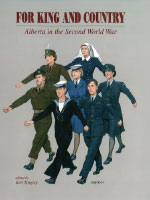Morale and Morality on the Alberta Homefront
Jeff Keshen
Reprinted with permission of the author and publisher of For King and Country: Alberta in the Second World War On the one hand, all these initiatives increased public awareness of matters not usually discussed, and with improved treatment facilities began bringing VD rates down by 1944.38 It was also a campaign that ended up infringing upon the freedom of women once it was shown that more than half of infected soldiers claimed that those from whom they contracted the disease were first encountered in a restaurant, dance hall, or on the street.39 Believing that prostitutes had taken their trade from bawdy houses to such locations, the military often declared "out of bounds" those establishments which were named as a contact place by more than one soldier with VD - locations which in Edmonton included the very popular International, Blue Willow, Regal and Arrow cafes.40 To avoid losing business, a number of such establishments, if warned by the military or police, were known to ask unaccompanied women to leave their premises. The same was true in dance halls and hotels, and even some taxi drivers refused to give a ride to young women on their own at night for fear of losing their licences if it was proven that they had knowingly transported a prostitute to an illicit rendezvous.41
On the one hand, all these initiatives increased public awareness of matters not usually discussed, and with improved treatment facilities began bringing VD rates down by 1944.38 It was also a campaign that ended up infringing upon the freedom of women once it was shown that more than half of infected soldiers claimed that those from whom they contracted the disease were first encountered in a restaurant, dance hall, or on the street.39 Believing that prostitutes had taken their trade from bawdy houses to such locations, the military often declared "out of bounds" those establishments which were named as a contact place by more than one soldier with VD - locations which in Edmonton included the very popular International, Blue Willow, Regal and Arrow cafes.40 To avoid losing business, a number of such establishments, if warned by the military or police, were known to ask unaccompanied women to leave their premises. The same was true in dance halls and hotels, and even some taxi drivers refused to give a ride to young women on their own at night for fear of losing their licences if it was proven that they had knowingly transported a prostitute to an illicit rendezvous.41
Complaints came from some women's groups who said that those who joined the workforce, especially as a patriotic gesture to free up more men for military service, had a right to enjoy themselves in the evening. Widespread sympathy was not generated, however; in addition to convictions about protecting Canada's fighting men from disease, many citizens, while willing to accept large-scale female labour as a wartime necessity, nevertheless believed it important to retain some restraints over their conduct lest they develop too much independence and lose attachment to their first priority - the family. Fearing such disintegration, Calgary's Chief of Police went so far as to accuse "working girls" of being the cause of much VD, especially those who worked late and then, he intimated, gallivanted around with their extra cash.42
Although considerable criticism was expressed over this position even in Alberta, where industrial war jobs for women were relatively limited, some "troubling" trends became evident to those concerned about family stability. Edmonton's Local Council of Women, in demonstrating a realization that females were more than capable of performing traditional male jobs, spoke out in favour of equal pay for equal work; when dismissed from well paid positions at places like Aircraft Repair Limited, the Local Council insisted that the Liberal government live up to its election pledge of June 1945 to secure full employment by creating more jobs for everyone, as opposed to "forcing Jill back into the kitchen".43
No doubt countless women, after years of strain and loneliness, as well as the double bind of home and outside work, gladly chose marriage, children, and sole custody of the domestic sphere after the war. But clearly the stress upon traditional family life in the 1950s was also a societal reaction against perceived threats to its sanctity during the conflict. When married women began re-entering the workforce in substantial numbers during that decade, not only was it principally in pink-collar jobs such as the retail sector, but also usually on a part-time basis and only after their children reached school age. For hand-in-hand with the new wartime roles for women came what many perceived as unsettling attitudes and the inadequate care of youth; in order to correct this situation governments supported the return of mothers to the home rather than sanction facilities which held out the possibility of making their full-time employment a permanent feature of Canadian society.
This certainly became evident with the issue of day nurseries and day care, which Alberta was considering implementing in late 1943 on a 50-50 shared cost basis with Ottawa under the provisions of a federal act passed the previous year. Even in Ontario and Quebec, where the concentration of war industry forced approximately thirty such centres to open, the supply of space fell far short of demand; officials insisted upon interpreting the term "war worker" [for whose children eighty per cent of space was reserved] narrowly in order to keep the number of applicants down and prevent women from regarding the measure as anything more than a temporary expedient. In Alberta the government proved more hard-headed; despite the wartime employment of thousands of women, it simply maintained that state-financed day care was unjustifiable since most jobs did not relate directly to the conflict, thus ignoring the fact that private crèches already were near the breaking point. At the single downtown facility in Edmonton in 1942, 118 children aged two to thirteen attended at different times of the day, in buildings which according to the owners could perhaps accommodate another ten at the most. In Edmonton and Calgary, committees were formed to lobby for government day care, as well as for after-hours and lunchtime supervision for those at school, the availability of which depended upon the decision of the individual institution. Some businesses which depended upon women workers were supportive, such as Edmonton's Great Western Garment Company, which manufactured uniforms; the GWG president reported that from May to July 1943, his female staff fell from 470 to 377 due to an inability of mothers to find acceptable child care services.44
Still, the provincial government resisted, only agreeing in late 1943 to place some newspaper advertisements asking people to write in if favouring such a programme. It was an approach denounced by day care advocates. Many female workers, they pointed out, only read Ukrainian. Moreover, the advertisements failed to cite the subsidized fees of state-supported centres and strongly suggested that only the children of those directly involved with war work would qualify, thus guaranteeing a less than overwhelming response.45
Not only did the determination to protect the traditional family structure scuttle day care, but also, somewhat ironically, drew strength from one of the consequences of that policy - children were too often left without adequate supervision. Newspapers and magazines across the land bemoaned so-called "car babies" left all day in parking lots while the mother worked, or if older, the "latchkey child" who returned home at lunch or after school to an empty house. This neglect, it was said, was producing a generation of maladjusted youth and juvenile delinquents.
Notes
38. NAC, RG 24, Records of the Department of National Defence, Vol. 12216, File 218-4, Venereal Disease in the Canadian Army in Canada, 31 Dec. 1945.
39. PAA, 68.145, 1943 Report, 97.
40. LS, Regimental Orders, 19 Sept. 1940.
41. PAA, 68.145, 1943 Report, 91-2.
42. Calgary Police Archives, Records of the Police Commission, File 42-12, Undated clipping from Calgary Albertan.
43. GL, MG 5841, 1944 Yearbook, 19; 1946 Yearbook, 37-8.
44. CE, RG 11, Class 32, File 7, Brief submitted to City Council from Council of Social Agencies, Summer 1943; F.D. Sutcliffe to Council of Social Agencies, 21 Sept. 1943.
45. Ibid, Information Regarding the Wartime Day Nursery Situation in Edmonton Presented to the City Council of Edmonton by the Day care Committee of the Edmonton Council of Social Agencies, 12 June 1944.








